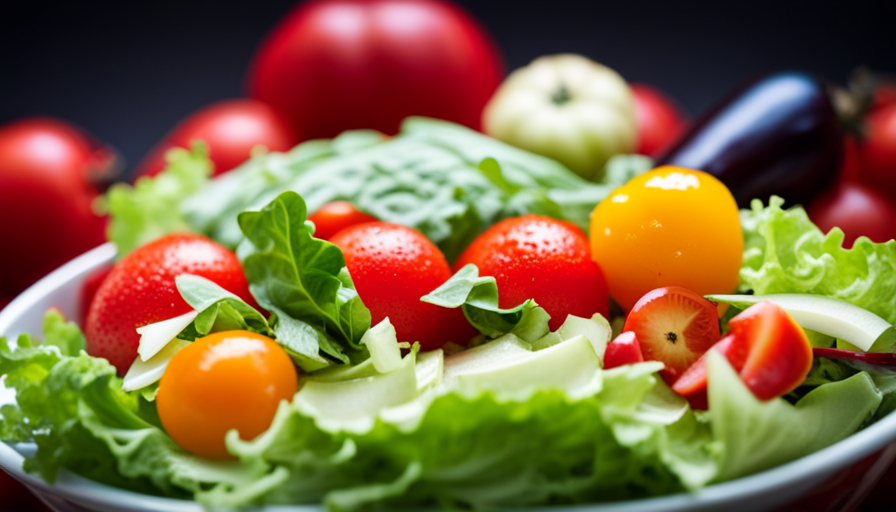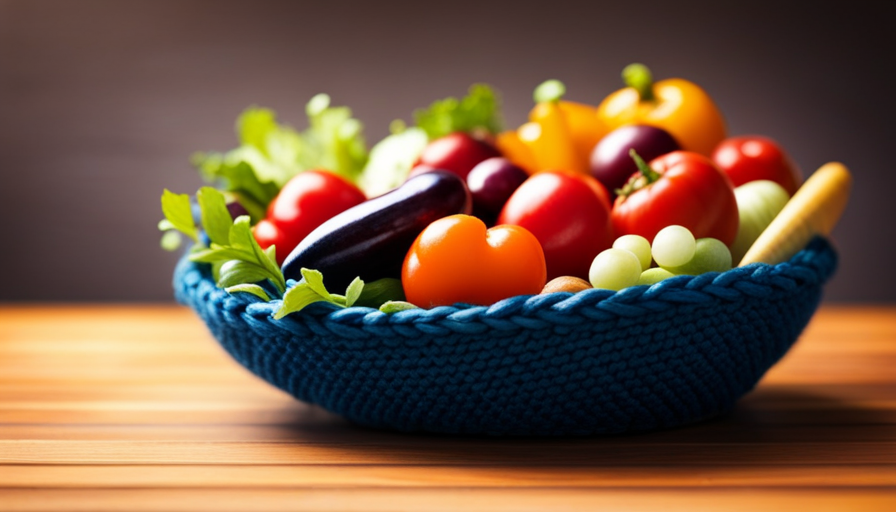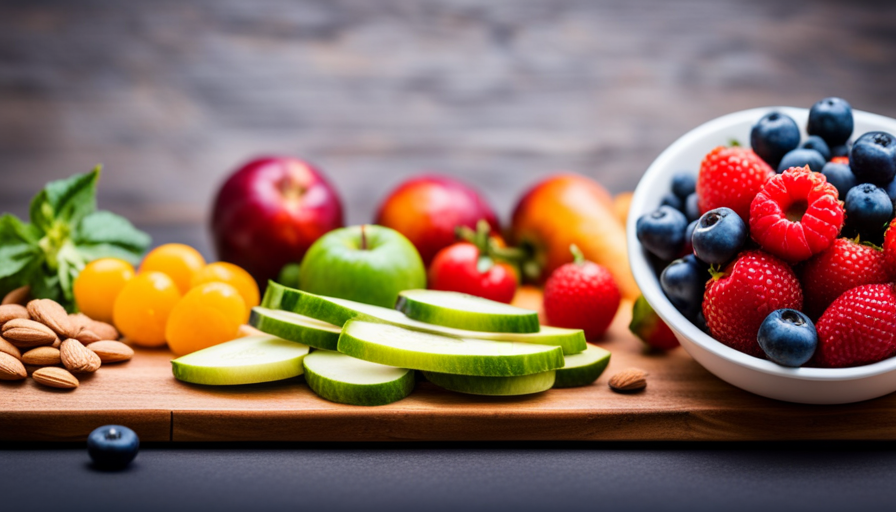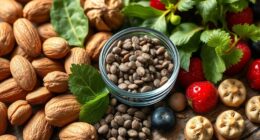Imagine a lively garden filled with a variety of colors, each representing the different nutrients and health benefits found in raw food. This is the heart of the raw food lifestyle, a diet that celebrates the freshness and energy of unprocessed ingredients.
In this article, I will guide you through the world of raw food and provide you with valuable insights on what to eat to nourish your body and elevate your health.
By incorporating fresh fruits and vegetables into your diet, you not only indulge in their natural sweetness but also reap the benefits of their abundant vitamins, minerals, and antioxidants. Additionally, experimenting with nutritious nuts and seeds can provide you with essential fatty acids and protein.
But that’s not all – raw dairy and fermented foods offer a range of probiotics and enzymes that can support a healthy gut, while raw superfoods pack a powerful punch of nutrients. Learning how to make raw soups and salads can bring a refreshing twist to your meals, and indulging in raw desserts and treats can satisfy your sweet tooth without compromising your health.
So, let’s dive into the world of raw food and discover the endless possibilities it holds for nourishing our bodies and embracing a vibrant, wholesome lifestyle.
Key Takeaways
- Raw food includes fresh fruits and vegetables, nutritious nuts and seeds, raw dairy and fermented foods, and raw superfoods.
- Incorporating raw food into the diet can improve digestion, boost energy levels, promote weight loss, and enhance overall health and well-being.
- Ways to incorporate raw food into the diet include snacking on fresh fruits and vegetables, adding them to favorite recipes, using nuts and seeds in dishes, trying fermented vegetables and raw dairy recipes, and making raw superfood recipes.
- Other ideas for incorporating raw food into the diet include making green smoothies, chia pudding, raw chocolate avocado mousse, and raw soups and salads, as well as experimenting with different dressings and learning raw food techniques.
Explore the Benefits of Raw Food
Discover the multitude of advantages that come with incorporating raw food into your diet and experience a whole new level of vitality and well-being.
Explore the science behind raw food and discover the health benefits of a raw food diet. Raw food enthusiasts believe that cooking can destroy the natural enzymes and nutrients present in food, whereas consuming food in its raw state ensures that these vital components remain intact.
Research suggests that raw food can improve digestion, boost energy levels, and promote weight loss. Additionally, raw food is rich in antioxidants, which help fight against free radicals and reduce the risk of chronic diseases.
Incorporating fresh fruits and vegetables into your diet is a simple yet effective way to embrace raw food. Fruits like apples, oranges, and berries are packed with vitamins and minerals, while vegetables like spinach, kale, and cucumbers provide essential nutrients and fiber.
By incorporating these raw foods into your diet, you can enhance your overall health and well-being.
Incorporate Fresh Fruits and Vegetables into Your Diet
Try incorporating fresh fruits and vegetables into your diet to see if it truly enhances your overall well-being. There are many ways to incorporate raw food in your daily routine and increase your intake of these nutritious foods.
One simple way is to have a fruit or vegetable with every meal. For breakfast, you can add sliced bananas or berries to your cereal or yogurt. At lunch, include a side salad or add chopped vegetables to your sandwich. And for dinner, make sure to have a serving of steamed or raw vegetables alongside your main dish.
Another way to increase your intake of fresh fruits and vegetables is to snack on them throughout the day. Instead of reaching for processed snacks, grab an apple, carrot sticks, or cherry tomatoes. These snacks not only provide essential vitamins and minerals, but also fiber, which can help keep you feeling full and satisfied.
Additionally, try incorporating fresh fruits and vegetables into your favorite recipes. You can add spinach or kale to your smoothies, top your pizza with a variety of colorful vegetables, or make a stir-fry with an assortment of veggies. Experimenting with different recipes can make eating raw food more enjoyable and exciting.
By incorporating fresh fruits and vegetables into your diet, you can increase your intake of essential nutrients and improve your overall well-being. So, why not give it a try and see the positive impact it can have on your health?
Now, let’s transition into the next section and explore the benefits of experimenting with nutritious nuts and seeds.
Experiment with Nutritious Nuts and Seeds
Incorporating a variety of nutritious nuts and seeds into your diet can add a delightful crunch and burst of flavor to your meals. Not only do they enhance the taste of your dishes, but they also offer numerous health benefits.
Here are a few reasons why you should experiment with these nutrient-rich gems:
-
Abundance of essential nutrients: Nuts and seeds are packed with vitamins, minerals, and antioxidants that are crucial for maintaining overall health. They’re particularly rich in heart-healthy fats, fiber, and protein, making them a great addition to any raw food recipe.
-
Promote satiety and weight management: The high protein and fiber content in nuts and seeds can help you feel fuller for longer, aiding in weight management. Including them in your meals can prevent cravings and overeating, supporting a healthy lifestyle.
-
Boost brain health: Many nuts and seeds contain omega-3 fatty acids, which’re known to support brain function and improve cognitive abilities. Incorporating these into your diet may enhance memory and concentration.
-
Versatile and delicious: From almond butter to chia seed pudding, the possibilities’re endless when it comes to incorporating nuts and seeds into your recipes. They can be used in both sweet and savory dishes, adding texture and flavor to your meals.
By incorporating a variety of nutritious nuts and seeds into your diet, you can enjoy not only the delightful taste but also the numerous health benefits they offer.
Now, let’s explore the next step and try incorporating raw dairy and fermented foods into your raw food journey.
Try Raw Dairy and Fermented Foods
To truly enhance your raw food journey, it’s time to embrace the incredible benefits of raw dairy and fermented foods.
Raw dairy, such as milk, cheese, and yogurt, offers a plethora of nutrients that can boost your overall health. Not only is raw dairy rich in essential vitamins and minerals, but it also contains beneficial enzymes and probiotics that support digestion and promote a healthy gut. Additionally, raw dairy is a great source of high-quality protein, which is essential for muscle growth and repair.
Fermented foods, on the other hand, are packed with probiotics that can improve your gut health and strengthen your immune system. Some popular fermented foods include sauerkraut, kimchi, and kefir. These foods undergo a natural fermentation process that breaks down sugars and starches, making them easier to digest and increasing their nutrient content. Moreover, fermented foods can help increase the absorption of nutrients from other foods, making them a valuable addition to a raw food diet.
To incorporate raw dairy and fermented foods into your raw food journey, you can try making your own fermented vegetables or experiment with different types of raw dairy recipes. From homemade yogurt to flavorful cheese, there are countless possibilities to explore. By including these nutrient-rich foods in your diet, you can take your raw food journey to the next level and enjoy the many benefits they offer.
Now, let’s delve into the next section and discover the power of raw superfoods.
Discover the Power of Raw Superfoods
Now is the time to unlock the incredible benefits of raw superfoods and experience their transformative power. Raw superfoods are packed with essential nutrients and enzymes that are often lost during cooking or processing. They are an excellent addition to a raw food diet, providing a wide range of health benefits. Incorporating raw superfoods into your daily meals can be both delicious and nourishing.
To help you get started on your raw superfood journey, here are some raw superfood recipes that you can try:
| Recipe | Ingredients | Benefits |
|---|---|---|
| Green Smoothie | Spinach, kale, banana, almond milk | Rich in antioxidants and fiber, aids in weight loss |
| Chia Pudding | Chia seeds, coconut milk, berries | High in omega-3 fatty acids, promotes healthy digestion |
| Raw Chocolate Avocado Mousse | Avocado, cacao powder, honey | Packed with antioxidants, supports heart health |
| Raw Energy Balls | Dates, nuts, coconut | Provides a natural energy boost, great for snacking |
Incorporating raw superfoods into your diet can also be beneficial for weight loss. These nutrient-dense foods are low in calories and high in fiber, helping you feel fuller for longer and reducing cravings.
As you explore the world of raw superfoods, you’ll discover endless possibilities to create delicious raw smoothies and juices.
Create Delicious Raw Smoothies and Juices
Get ready to tantalize your taste buds and experience the pure bliss of blending together a variety of vibrant fruits and vegetables to create irresistibly refreshing smoothies and juices. Not only are these drinks delicious, but they also offer numerous health benefits.
Here are three mouthwatering smoothie recipes to get you started:
-
Tropical Paradise: Blend together juicy pineapple, creamy coconut milk, and a handful of spinach for a tropical delight that’s packed with vitamins, minerals, and antioxidants. This refreshing smoothie will transport you to a sunny beach getaway.
-
Berry Blast: Combine a mix of berries like strawberries, blueberries, and raspberries with almond milk and a dollop of Greek yogurt for a protein-packed treat. Loaded with antioxidants and fiber, this smoothie will keep you feeling full and satisfied.
-
Green Goddess: Create a vibrant green smoothie by blending together kale, cucumber, kiwi, and a splash of lemon juice. This power-packed drink is rich in vitamins A, C, and K, as well as iron and calcium.
In addition to the delicious flavors, juicing also offers numerous health benefits. It allows for easy absorption of nutrients, boosts the immune system, and promotes detoxification.
Now, let’s transition into the next section and learn how to make raw soups and salads.
Learn how to Make Raw Soups and Salads
Indulge in the vibrant and refreshing world of raw soups and salads, where you can create colorful and nutritious meals that’ll leave you feeling energized and satisfied.
Raw food recipes offer a plethora of options to tantalize your taste buds while nourishing your body. Raw soups are a great way to incorporate a variety of fresh vegetables and herbs into your diet. By blending them together, you can create creamy and flavorful soups without the need for cooking. From classic gazpacho to creamy avocado soup, the possibilities are endless.
Raw salads are another delightful way to enjoy the goodness of raw food. By combining different vegetables, fruits, nuts, and seeds, you can create a symphony of flavors and textures. The key to a delicious raw salad is to choose a variety of colorful ingredients that provide a range of nutrients. You can experiment with different dressings, such as lemon tahini or mango vinaigrette, to add a burst of flavor.
Learning raw food techniques can enhance your culinary skills and introduce you to a whole new world of healthy eating. From spiralizing vegetables to create raw pasta to using a dehydrator to make raw crackers, the possibilities are endless. Incorporating more raw food into your diet can lead to increased energy levels, improved digestion, and enhanced overall well-being.
As you explore the world of raw soups and salads, you’ll be amazed at the variety and creativity that can be achieved with raw food techniques. So, get ready to indulge in the vibrant flavors of raw desserts and treats that’ll satisfy your sweet tooth without compromising your health.
Indulge in Raw Desserts and Treats
Are you ready to satisfy your sweet tooth with a mouthwatering array of guilt-free desserts and treats? Raw desserts recipes are a great way to indulge in something sweet while maintaining a healthy lifestyle. Here are three delicious raw dessert ideas to try:
-
Raw Chocolate Avocado Mousse: This creamy and decadent dessert is made with ripe avocados, cacao powder, and a touch of sweetener. It’s packed with healthy fats and antioxidants, making it a guilt-free treat.
-
Raw Vegan Cheesecake: Made with a nut and date crust and a creamy cashew-based filling, this raw cheesecake is a crowd-pleaser. You can customize the flavors by adding fruit, chocolate, or spices to create your own unique twist.
-
Raw Coconut Bliss Balls: These bite-sized treats are perfect for on-the-go snacking. Made with dates, nuts, and shredded coconut, they’re sweet, chewy, and full of natural energy.
Raw treats for beginners can be a delicious way to introduce raw food into your diet. They’re easy to make and require minimal ingredients. So why not indulge in some guilt-free sweetness today?
Now that you’ve satisfied your sweet tooth, let’s transition into the next section about how to plan a raw food meal prep without compromising on taste.
Plan a Raw Food Meal Prep
When it comes to indulging in raw desserts and treats, there’s no denying the satisfaction they bring to our taste buds. But now, let’s shift our focus to something equally important: planning a raw food meal prep. Meal prepping is a crucial aspect of maintaining a healthy raw food diet, as it allows us to save time, stay organized, and ensure we have nutritious meals readily available throughout the week.
To help you get started on your raw food meal prep journey, I’ve compiled some helpful tips and tricks. Firstly, it’s essential to choose a variety of raw food recipes that provide a balance of nutrients. Incorporating different fruits, vegetables, nuts, and seeds ensures you’re getting a wide range of vitamins, minerals, and antioxidants.
Next, it’s time to create a meal plan and gather all the necessary ingredients. To make it easier for you, I’ve prepared a table below with a sample meal plan for a day, consisting of breakfast, lunch, dinner, and snacks. This will give you an idea of how to structure your meals and ensure you’re meeting all your nutritional needs.
| Meal | Recipe | Ingredients |
|---|---|---|
| Breakfast | Green Smoothie | Spinach, banana, almond milk |
| Lunch | Raw Veggie Salad | Mixed greens, veggies, nuts |
| Dinner | Zucchini Noodles | Zucchini, tomato sauce, herbs |
| Snacks | Fresh Fruit | Apples, oranges, berries |
With these meal prep tips and a well-planned raw food menu, you’ll be well-equipped to embrace the raw food lifestyle. But before we dive into that, let’s explore the benefits of incorporating raw foods into our diet.
Embrace the Raw Food Lifestyle
Embrace the raw food lifestyle and discover a world of vibrant, nutrient-rich meals that’ll leave you feeling energized and nourished. Transitioning to a raw food diet can seem daunting at first, but with the right raw food recipes and a little planning, it can become a seamless part of your daily routine.
One of the best ways to embrace the raw food lifestyle is to start experimenting with raw food recipes. There are countless delicious and creative options available, from refreshing salads to zucchini noodles with pesto sauce. Incorporating a variety of fruits, vegetables, nuts, and seeds into your meals will ensure that you’re getting a wide range of nutrients.
When transitioning to a raw food diet, it’s important to take it slow and listen to your body. Gradually increase the amount of raw food in your meals and pay attention to how you feel. Some people find that they feel more energized and lighter when they eat raw, while others may need to make adjustments to find their optimal balance.
Remember, the raw food lifestyle is all about nourishing your body with whole, unprocessed foods. It’s not about deprivation or strict rules. So, have fun exploring new flavors and textures, and embrace the raw food lifestyle for a healthier, more vibrant you.
Frequently Asked Questions
Can raw food be safely consumed during pregnancy?
Raw food can be safely consumed during pregnancy, but it’s important to take precautions. According to a study published in the Journal of Food Protection, only 4% of raw food-related foodborne illnesses are associated with pregnancy. However, it’s important to note that pregnant women have weakened immune systems, making them more susceptible to foodborne illnesses.
To ensure safety, it’s recommended to thoroughly wash all fruits and vegetables, avoid unpasteurized dairy and juices, and properly cook meats and seafood. Always consult with a healthcare professional for personalized advice.
Are there any health risks associated with consuming raw food?
There are potential health risks associated with consuming raw food. While raw food can provide certain health benefits, such as higher nutrient content and enzymes, it also carries a higher risk of foodborne illnesses.
Raw food, like fruits, vegetables, and raw meats, can be contaminated with harmful bacteria or parasites. To ensure food safety, it is important to properly wash and handle raw food, as well as cook meats to appropriate temperatures.
How can I ensure I am getting enough protein on a raw food diet?
As a proud raw foodie, I ensure my protein intake by incorporating a variety of protein-rich sources into my diet. Raw food sources like nuts, seeds, and legumes are fantastic options.
I also love experimenting with plant-based protein recipes, such as raw vegan protein balls or a hearty lentil salad.
If I ever feel like I need an extra boost, I consider protein supplementation, like hemp or pea protein powder.
Meeting my protein needs on a raw food diet is absolutely achievable!
Can raw food help with weight loss?
Raw food can indeed help with weight loss. When we consume raw food, our body has to work harder to digest it, which can lead to increased calorie burn. Additionally, raw food is rich in fiber, which helps keep us feeling full and aids in digestion.
Raw food is also packed with essential nutrients that are easily absorbed by our body. However, it’s important to have a balanced diet and consult with a healthcare professional before making any major dietary changes.
Are there any specific tips for transitioning to a raw food diet?
Sure, when transitioning to a raw food diet, there are a few helpful tips to keep in mind. First, start by gradually incorporating more raw fruits, vegetables, nuts, and seeds into your meals.
Experiment with different raw food recipes to keep things interesting and tasty.
It’s also important to listen to your body and make sure you’re getting all the necessary nutrients, like protein and vitamins.
And don’t forget to stay hydrated and seek guidance from a healthcare professional.
Can I Use Raw Dog Food as a Guide for What to Eat on a Raw Food Diet?
Yes, you can use raw dog food as a guide for what to eat on a raw food diet. Raw dog food tips can help you choose nutrient-dense options like lean meats, fruits, and vegetables. Just make sure to consult with a nutritionist to ensure you’re meeting your dietary needs.
Conclusion
In conclusion, embracing the raw food lifestyle can be a transformative journey towards optimal health and well-being. By incorporating a variety of fresh fruits, vegetables, nuts, and seeds into our diets, we can unlock the powerful benefits of raw food.
From boosting our immune system to improving digestion and increasing energy levels, the evidence is clear. So why not embark on this delicious and nutritious adventure? Start by exploring the world of raw superfoods, experimenting with raw soups and salads, and indulging in guilt-free raw desserts and treats.
With proper meal planning and preparation, you can easily incorporate raw food into your daily routine. So go ahead and take the first step towards a vibrant and vibrant life with raw food.










